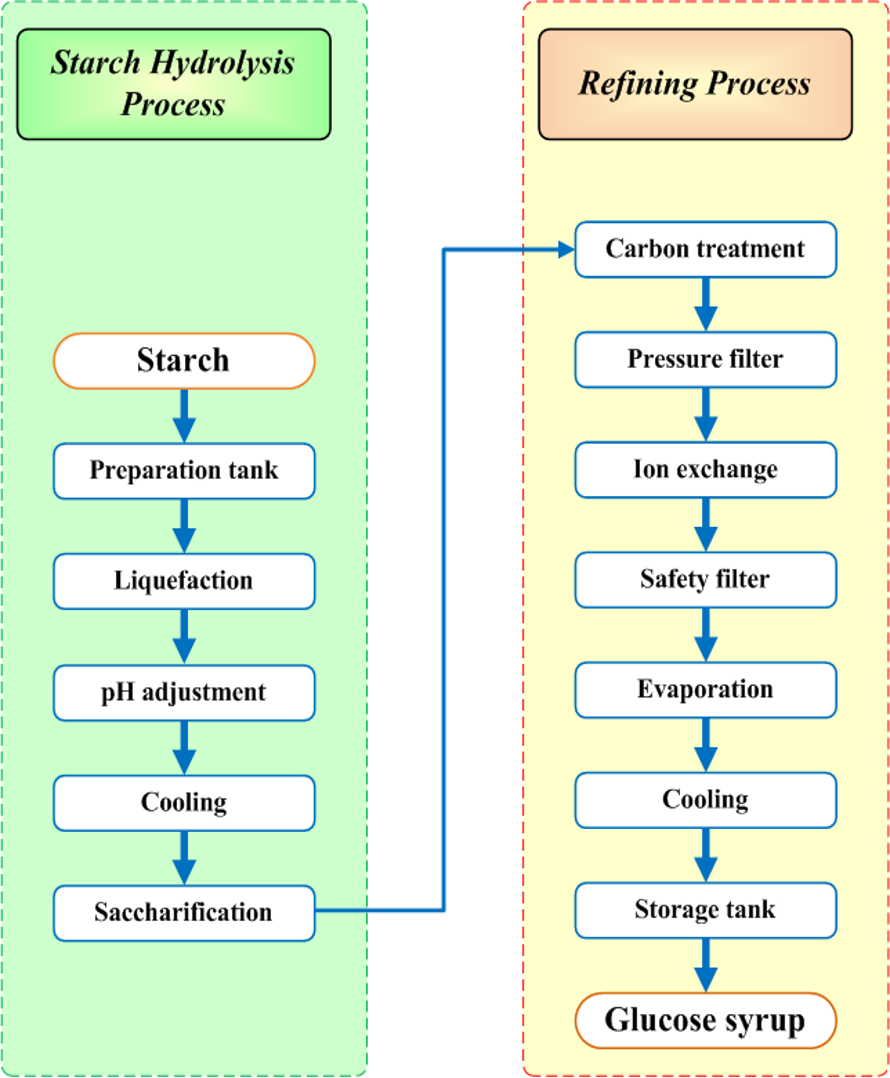Value-Added Products
STARCH MODIFICATION
Starch, when cooked, provides viscous paste and when cooled, it can form film and gel which are very useful for various applications. Furthermore, the functional properties of starch are diversified by starch modification which alters its viscosity, gel and film properties, as well as other functionality such as solubility, emulsification, lipophilicity, hydrophilicity, charge and digestibility. Therefore, starch can act as a thickener, texturizer, moisture retention aid, gelling agent, adhesive, binder, film forming agent, emulsifier, stabilizer, disintegrant and diluent in various products.
Starch modification is a process of making modified starch or starch derivatives which can be accomplished by physically, chemically or enzymatically treating native starch under the defined condition. Important modifications are:
1. Pregelatinized starch
Native starch is insoluble in cold water which can limit some applications. Pregelatinized starch or instant starch is cooked starch which is soluble, thickens and forms a gel in cold water without heat. It is produced by a physical process by which starch is cooked and dried. The drying can be achieved by drum drying, extrusion or spray drying. The common manufacturing process of pregelatinized starch involves drying of 30 – 40 % (dry solid) starch slurry on a roller drum drier heated to 160-170°C by direct steam.

Some modified cassava starch and derivatives which are used in food and non-food products
2. Converted starch
Converted starch is modified starch which provides low viscosity upon cooking as a result of starch depolymerization. This group of converted starches includes:
- Acid -thinned starch
Acid-thinned is chemically modified starch produced by treating native starch with acid such as hydrochloric acid. Acid-thinned starch provides a low viscous hot paste upon cooking so sometimes is referred to as thin-boiling starch. Cooked starch, when cooled, gives an opaque and firm gel. The film and gel forming properties of acid- thinned starch is advantageous for applications in confectionery, paper and textile.
- Oxidized starch
Oxidized starch is normally produced by the reaction of starch with sodium hypochlorite (NaOCl) under alkaline conditions. Oxidized starch is used at the size press as a surface sizing on a wide range of uncoated free sheets to strengthen the paper surface.
- Pyrodextrins
Pyrodextrin is obtained by roasting starch with mineral acids. The product has higher solubility, lower hot paste viscosity and improved film forming ability which can be used as a good adhesive.
- Enzyme-converted starch
Starch can be hydrolyzed by enzyme, yielding a product with improved solubility and lower viscosity. The product with a low degree of hydrolysis, defined as Dextrose Equivalent (DE), i.e. DE< 20 is called maltodextrin, which is commonly used in instant food products.
3. Derivertized starch
Etherified starch
Etherified starch is a chemically modified starch obtained by etherification of native starch with etherifying agents. By introducing substituents, the modified starch also carries the properties of those substituted groups. Some important commercial etherified starches are:
- Hydroxylpropyl starch which is obtained by reaction with propylene oxide. Hydroxypropyl starch has more viscosity and good freeze-thaw stability, which is preferred in frozen food products.
- Carboxymethyl starch (CMS) which is obtained by reaction with sodium monochloroacetate. CMS has the negative charge which promotes its hydration properties and is used as a disintegrant or binder in tablets for the pharmaceutical industry.
- Cationic starch. Cationic starch is obtained by reaction of starch with chemicals having amino, imino, ammonium, sulphonate or phosphonium groups. The commonly used chemical is quaternary ammonium starch ether. This starch contains positive charges and is preferred in paper making during wet end (i.e. internal sizing) process. Cationic starch with positive charge can strongly bind with the negatively charged cellulose of fibre and hence increase paper strength. It does not only promote the paper quality, but also improves the pulp retention and dewatering during the processing.
Esterified starch
Esterified starch is a chemically modified starch obtained by esterification of native starch with esterifying agents. Some important commercial esterified starches are:
- Starch acetate. The normal preparation process of starch acetate is the reaction with vinyl acetate monomer or acetic anhydride under an alkaline aqueous suspension. Starch acetate has greater viscosity, lower retrogradation or setback and improved freeze-thaw stability.
- Monostarch phosphate is obtained by reaction with orthophosphoric acid, sodium orthophosphate or sodium tripolyphosphate. This starch carries the negative charge, therefore, the paste has very high viscosity, clarity and stability. The starch has low tendency to retrograde and high freeze-thaw stability.
- Starch octenyl succinate. This starch is produced by reaction with octenyl succinic acid. The starch is substituted with octenyl succinyl group which has both hydrophilic and lipophilic parts so it can serve as an emulsifying agent.
Crosslinked starch
This starch is modified by multifunctional or cross-linking reagents which react on hydroxyl groups of starch in more than one group, introducing a crosslink or bridge on the starch. The commonly produced crosslinked starches are di-starch phosphate produced by reaction with sodium trimetaphosphate or phosphorous oxychloride and di-starch adipate produced by reaction with adipic acid. Under severe conditions such as low pH, high shear, high temperature and high pressure, crosslinked starch can be processed with low viscosity breakdown.
4. Starch hydrolysate and derivatives
One of the major applications of starch is in the sweetener industry, particularly glucose and fructose syrup. In addition, glucose is used as the starting raw material for producing other derivatives including sugar alcohol (sorbitol and mannitol), amino acids (monosodium glutamate (MSG) and lysine) and organic acids (lactic acid).
Glucose is produced by a two-stage enzyme hydrolysis of starch, namely liquefaction by liquefying enzymes, i.e. α-amylase and saccharification by saccharifying enzymes, i.e. glucoamylase. After hydrolysis, the syrup is purified by a series of treatments including filtration, activated-carbon and ion exchange (cation and anion exchange) treatment to improve impurities. The purified syrup is then concentrated by evaporation or dried to powder. Glucose is then used to produce other derivatives including:
- Fructose by isomerization process using isomerase enzyme
- Sorbitol and mannitol by hydrogentation
- Monosodium glutamate by microbial fermentation
- Lactic acid by microbial fermentation

Scheme of typical process of glucose syrup production from starch by enzyme hydrolysis.
Uses of starch, modified starch and starch derivatives
Food
Native tapioca starch is widely applied in food recipes such as bakery products. It is also used to produce extruded snacks and tapioca pearls. In addition, native, modified starches and starch derivatives are also important food ingredients serving as thickening, binding, texturizing, stabilizing, gelling, film forming, emulsifying and encapsulating agents in food products. They are also excellent fillers, sweeteners, flavour carriers and fat replacers. Food products containing starch and its derivatives are many and varied, such as canned food, frozen food, dry mixes, baked goods, snacks, noodles, dressings, soups, sauces, dairy products, meat and fish products and infant food.
Beverage
Modified starches are used as a colloid stabilizer in beverages that include solid constituents. Starch-based sweeteners are preferred to sucrose in beverages for their improved processing characteristics and product enhancing properties. Varying the combination of various sweetener components is readily accomplished to satisfy customer requirements. High dextrose equivalent syrups are excellent sources of easily fermentable sugar and are used by the brewery industry.
Confectionery
Starch products are used in confectionery to bring about gelling, thickening, texture stabilization, foam strengthening, crystal control, adhesion, film forming and glazing. Low viscous starches are used in gelled confectioneries such as jellies and gums. Powdered starches are used as the moulds for casting purposes. Starch-based polyols make the manufacture of sugar-free chewing gum possible.
Paper
Modified starches, commercial or on-site modification of native starch, are commonly applied in the paper industry to improve paper quality, increase production rates and improve pulp yield. Cationic starches are employed to flocculate pulp, increasing de-watering rates on the wet end. The starch remains in the finished paper, acting as an internal sizing agent to increase the paper strength. Low viscosity starches, such as oxidized starches, are applied as surface sizing to improve the strength and control ink absorption properties for printing and writing. Modified starches are also used as a pigment binder for surface coating to obtain a smooth, white paper.
Adhesive/ binder
Dextrins are excellent adhesives and used in many applications including corrugated board, paper-bags, laminated board, gummed paper, tapes, labels, stamps and envelopes. Starch and its derivatives also serve as adhesives or binders in animal feed, charcoal briquettes and constructing materials.
Textile
Starches are used in the textile industry as sizing agents to stiffen and protect the thread for improving weaving efficiency. They are also used as finishing agents to obtain smooth fabrics and colour thickeners to obtain sharp and durable printed fabrics.
Pharmaceutical, personal care, cosmetics
Native and modified starches are used as binders, fillers and disintegrating agents for tablet production. They can also be applied in some tablets to control release or targeted-delivery of the active pharmaceutical ingredients. Modified starch is used as the water absorber in sanitary products such as diapers and napkins. Dusting starch powder is used in medical gloves to facilitate wearing. Specialty modified starches are used as a carrier for skin moisturizers, which are frequently mineral oil based. Other modified starches are used as emulsifiers, encapsulating agents, sizing, thickeners etc. in personal care products.
Packaging
Starch can be used to produce a monomer, which can then be polymerized to form biodegradable polymers. Alternatively, native and modified starches can be employed or blended with synthetic biodegradable polymers to produce packaging materials that are biodegradable and more environmentally friendly. Loose-fill or foam starch is more preferred for cushioning material, due to the ease of decomposition.
Construction and building material
Starch can be used in cement preparation to reduce time of cement hardening. Starch with high viscosity can increase the viscosity of drilling mud and fills the partition of the well to prevent oil leakage. Starch is also used as an adhesive for production of gypsum plaster, gypsum and mineral fibre board.
Chemicals
Tapioca starch-based syrups are obtained economically by acid and/or enzyme processes and used as feedstock to make various chemicals, including monosodium glutamate, amino acids, organic acids, alcohols, ketones, vitamins and antibiotics.
